
We have all been there. “Not another “insert time here” moment”, when we feel like we are but a mouse on a wheel, a cog in the machine and we are not part of a movement nor mission. We feel uninspired, demotivated and that our role lacks the meaning it may have once had.
Seth Godin, author of ‘The Dip’, tells us that we can usually sense this moment coming. The signs are always there, we can choose to listen or to ignore.
We see this time and time again with organisations as well as entire industries. There are a few ways we can react.
We can be an ostrich and stick our heads in the sand and hope it goes away. This reminds me of an episode of South Park where the townsfolk are instructed to duck and cover should the volcano erupt and lava comes their way. As you would expect, that does not end well…
Then we can always flee (take flight) or we can fight — as in the old “fight or flight” response. “Fight” in this instance means using regulation or legal action to fight new disruptions. This is akin to the Dutch boy finger in the dam. We are usually fighting a shifting pattern of behaviour or new technology.
The most viable, most risky and (if successful) most profitable is to “pioneer” or as we have discussed in previous Thursday Thoughts, to jump to a new “S” curve.
While we mostly think of these approaches in respect to organisations and industries, we can also apply this thinking to our careers. Here are some “personas” we may recognise (maybe you may see yourself?).
Ostriches
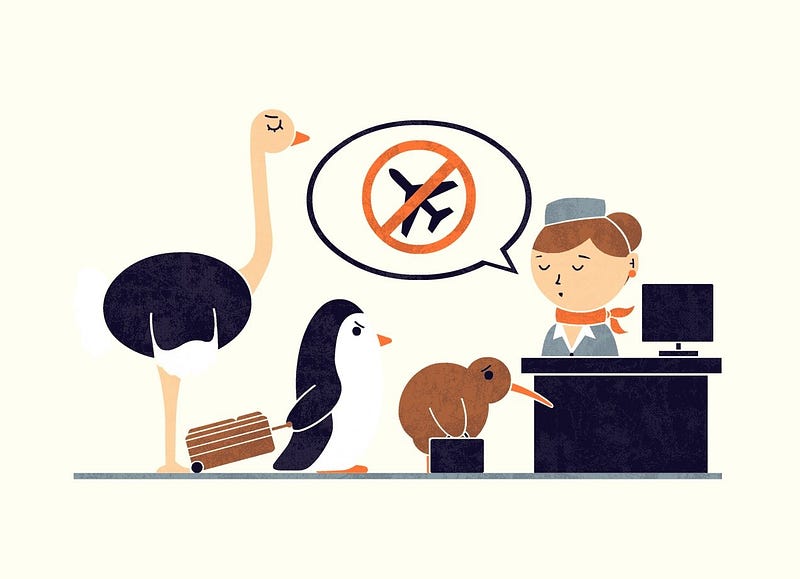
We all know these people (maybe this is you). They often work in organisations that are allergic to change, disruption and innovation, they are devoid of imagination. They are riddled with corporate politics, status quo and change blockers.
The reason people do not leave these organisations are manifold. Staff are usually too well paid and have a large pension en route should they “stick out” the misery of their role. They know that they are sacrificing purpose and meaning for the security and comfort of how things always are.
These people are usually either miserable or apathetic and they always block change.
According to this Harvard School of Public Health “Workplace and Health” report, 44% of working adults say their job adversely affects their health. Lower skilled workers claim their jobs causes them dissatisfaction, high stress levels, poor eating and sleeping patterns.
While I appreciate that neither access to education, nor the quality of said education is evenly distributed, I do believe we have to be proactive in our work careers.
One of the best pieces of (sporting) advice I have ever gotten is to never wait for the game to happen, you have to happen to the game.
We all realise that (and we should tell younger workers and recent graduates) there is no strategist, no CEO, no MD sitting in an office somewhere designing the future direction of our careers. This is our responsibility, this is our future, we have to happen to our careers.
Even once we are in a stable career and indeed we excel in that career, we still need to take charge and oftentimes we need to commit career “S”uicide.
Why is the “S” called out?
For regular followers of The Thursday Thought, you will be familiar with my fondness of “S” curves, for those new readers, here is a quick version.
S Curves
S curves are a great way to map both business and product lifecycles and they can also apply to your career. S curves follow the shape of the letter S with a flat start with early adopters and niche clientele. Rapid growth comes next, with a sudden peak after the flat start, finally comes a dominant position in the market.
After the rapid growth phase, businesses or products begin to plateau and experience stagnation, optimisation, automation, job cuts and quite often a me-too proposition.
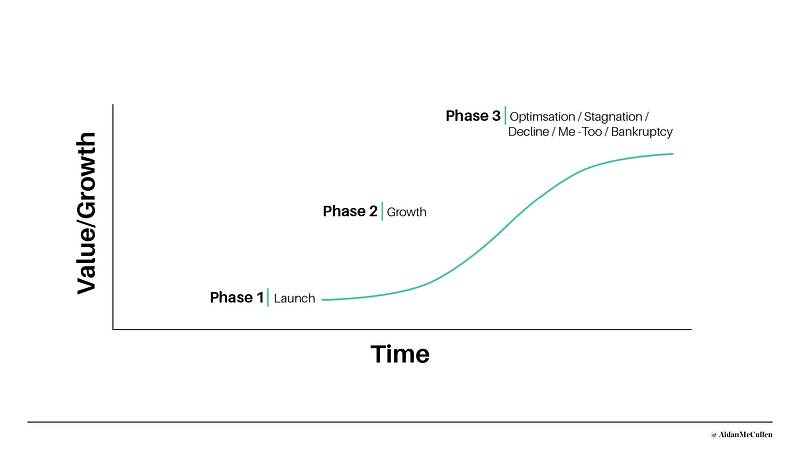
To Innovate Companies and Leaders need to jump from one S curve to another, but few have the courage to do so. The jump always looks like a step backwards.
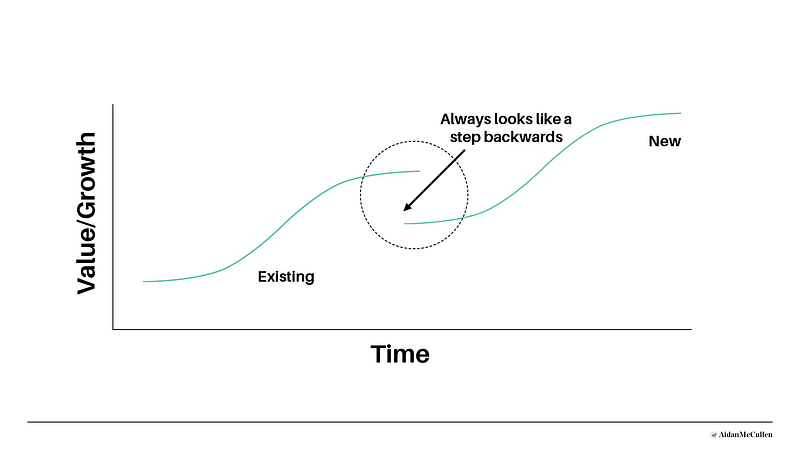
When Blockbuster CEO, Jim Keyes took over he ignored the next ideal jump for Blockbuster, which was a more ideal Blockbuster. When quizzed over why he turned down the option to acquire Netflix he stated: (for under 1 million) “Neither RedBox nor Netflix are even on the radar screen in terms of competition”. Not long after Blockbuster went bankrupt and we know the success story Netflix is today.
From Keyes perspective, he was doing a good job focussing on what Blockbuster did well today and felt looking at the next jump (which looks like a step back) was a distraction.
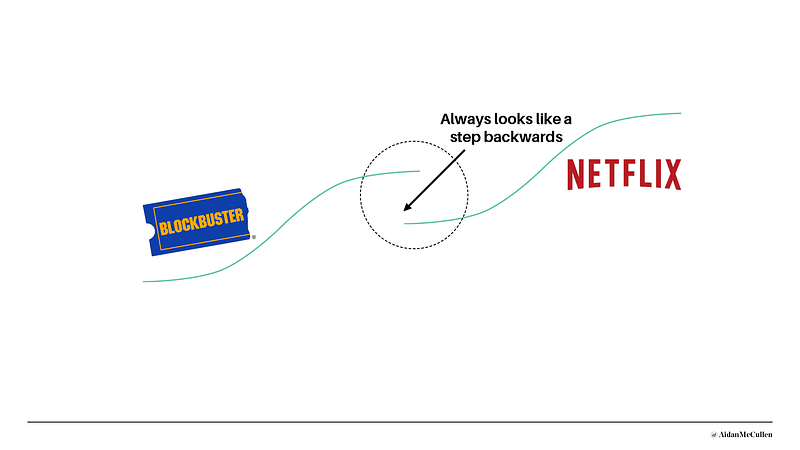
All of these occurrences happen in our careers too.
Committing Career “S”uicide
While I fully appreciate, this takes bravery, this takes partner/spousal support. The very brave, the pioneers, the mavericks jump their career S curve. They realise that they have peaked, they are at the top of their game.
Often when we reach the peak of what we do, we still remain unhappy and dissatisfied. Imagine we were all content in the world, nothing would improve. We need some unreasonable people for the world to progress.
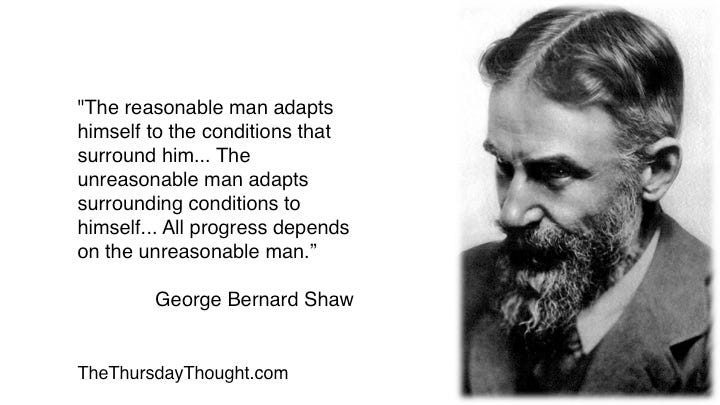
To the person who changes, who evolves and who adapts when they have no reason to do so except for an internal dissenting voice, I say, bravo, I tip the cap to you. I think it is great that the extremely low percentage of the world’s workers will do this. I also think that these people are usually the people who leave organisations and become entrepreneurs, when they should be the very people nurtured by organisations and help them pioneer and change their own company.
Alas, many organisations do not understand these people, they call them out as strange, as troublemakers, as unfocused and many other synonyms. As has been called out in so many alien/monster and outlier movies, man destroys what he does not understand. Unfortunately, this is the case for pioneers and this is why they leave organisations and help the world progress in other ways.
On this week’s innovation show we talk to Whitney Johnson, author of the critically acclaimed book ‘Disrupt Yourself (TM): Putting the Power of Disruptive Innovation to Work’ (2015) and ‘Dare, Dream Do’ (2012). Whitney also hosts the ‘Disrupt Yourself’ podcast.
We talk about why everyone should consider disrupting their career, what the benefits are, how companies can assist and nurture disruption and much more. You can find out more about Whitney at http://whitneyjohnson.com/meet-whitney/
You can find a link that Whitney mentions on the show here: http://whitneyjohnson.com/innovationshow and http://whitneyjohnson.com/innovationsystem
The show is broadcast on RTÉ Radio 1 extra 3 times weekly and on iTunes, TuneIn and and Google play. Website is here and below is Soundcloud.